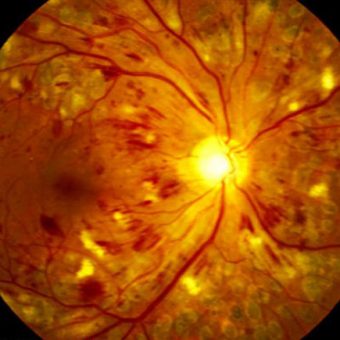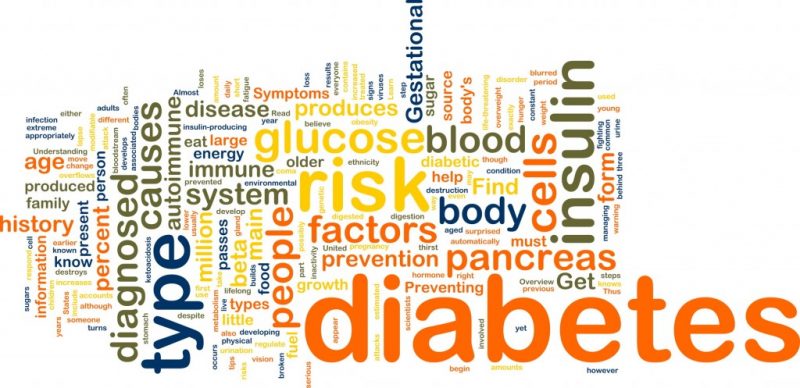As part of Diabetes Awareness Month, our first blog for November will be about diabetes and how it can affect our eyes. Currently, there are approximately 3.3 million people in Canada living with diabetes in which 90% are Type 2. It is expected that the prevalence of diabetes will double by 2025.
 Diabetes affects the eyes by altering the natural balanced composition of barriers in the eye or by affecting the blood vessels that supply structures of the eye including the lens, blood vessels, and eye muscles. Since there is a build up of sugar in the blood vessels throughout the body, the sugar enters the cells and structures which compromises the integrity of the blood vessels and changes the chemical composition of structures. In the lens, high levels of glucose can cause it to swell, become less clear, or more opaque resulting in a diabetic cataract. People with diabetes are at a higher chance of developing cataracts at a younger age. If the blood vessels that supply the retina (back of the eye) are compromised, small hemorrhages (bleeding) or deposits (of cholesterol or other fats) start leaking into the retina.
Diabetes affects the eyes by altering the natural balanced composition of barriers in the eye or by affecting the blood vessels that supply structures of the eye including the lens, blood vessels, and eye muscles. Since there is a build up of sugar in the blood vessels throughout the body, the sugar enters the cells and structures which compromises the integrity of the blood vessels and changes the chemical composition of structures. In the lens, high levels of glucose can cause it to swell, become less clear, or more opaque resulting in a diabetic cataract. People with diabetes are at a higher chance of developing cataracts at a younger age. If the blood vessels that supply the retina (back of the eye) are compromised, small hemorrhages (bleeding) or deposits (of cholesterol or other fats) start leaking into the retina.
 The most common cause of vision loss in diabetes is macular edema. This is when fluid starts leaking into the macula (part of the retina that provides the sharpest vision) and does not allow the macula to function properly. When blood flow to the retina is compromised, new blood vessels start to form that are fragile and irregular. These new blood vessels do not actually help the retina and often have scar tissue that grow along with them that pulls on the retina causing it to wrinkle or detach. If the retina detaches, this can often lead to permanent blindness depending on the severity and how much of the retina detaches. Another way diabetes can damage the eyes is by causing glaucoma. When new blood vessels grow in the wrong place that block the normal flow of fluid in the eyes, the pressure increases and damages the optic nerve.
The most common cause of vision loss in diabetes is macular edema. This is when fluid starts leaking into the macula (part of the retina that provides the sharpest vision) and does not allow the macula to function properly. When blood flow to the retina is compromised, new blood vessels start to form that are fragile and irregular. These new blood vessels do not actually help the retina and often have scar tissue that grow along with them that pulls on the retina causing it to wrinkle or detach. If the retina detaches, this can often lead to permanent blindness depending on the severity and how much of the retina detaches. Another way diabetes can damage the eyes is by causing glaucoma. When new blood vessels grow in the wrong place that block the normal flow of fluid in the eyes, the pressure increases and damages the optic nerve.
 Although diabetic eye disease can be very serious, it can be prevented. People with diabetes need to control their blood sugar. The damaging effects of diabetes only occur when the blood sugar fluctuates a lot (from very high to very low) within a short period of time or is consistently not controlled. The longer a person has diabetes the more likely they are to develop diabetic eye disease, but as long as it is controlled, the eyes should be less affected. Other factors that increase the likelihood of developing diabetic eye disease include smoking, high blood pressure, and alcohol consumption.
Although diabetic eye disease can be very serious, it can be prevented. People with diabetes need to control their blood sugar. The damaging effects of diabetes only occur when the blood sugar fluctuates a lot (from very high to very low) within a short period of time or is consistently not controlled. The longer a person has diabetes the more likely they are to develop diabetic eye disease, but as long as it is controlled, the eyes should be less affected. Other factors that increase the likelihood of developing diabetic eye disease include smoking, high blood pressure, and alcohol consumption.
It is crucial for diabetics to get regular eye exams once a year (sometimes more) to monitor and diagnose any changes seen in the eye. If diabetic eye disease is seen in the eye, it is a good indication of how well the diabetes is being controlled.
Visit us at Wink, your local Burnaby optometrist, to have your eyes checked today! We utilize retinal photography and scanning to help monitor and detect diabetic eye disease at earlier stages.



Pingback: The Aging Eye – Cataracts | Optometry Blog – Wink Optometry